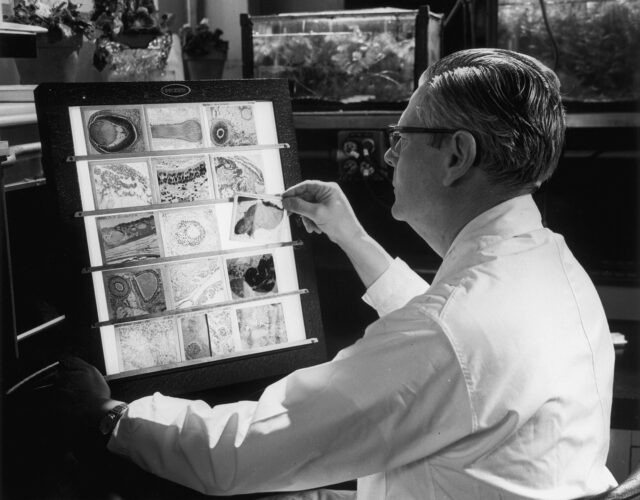Jacob Darwin Hamblin. Arming Mother Nature: The Birth of Catastrophic Environmentalism. Oxford University Press, 2013. 308 pp. $29.95.
In 1960 a catastrophic, weeklong series of earthquakes struck Chile, resulting in the flooding of several hundred miles of coastline, the deaths of thousands of Chileans, and the displacement of millions more. For civilian observers, in the words of the New York Times and as quoted by Jacob Hamblin in Arming Mother Nature, the quake “gave tragic testimony that in this age of the conquest of the atom and of triumphs in outer space man is still helpless against the vast and still largely unpredictable forces that frequently go berserk in his immediate environment—hurricanes, volcanoes and earthquakes” (p. 141). Cold War scientists, engineers, and strategists on both sides of the Iron Curtain saw this vulnerability of man to natural catastrophe from a very different angle.
To the North Atlantic Treaty Organization (NATO) the Chilean earthquake was an example of potential military destruction, if the explosive power of nuclear weapons could in the future be combined with knowledge of the dynamic nature of the oceans, continents, and climate. According to Hamblin, “Environmental cataclysms could become part of the alliance’s arsenal, with the help of a well-placed nuclear explosion” (p. 141). Hamblin provides many examples to illustrate what NATO and other like-minded organizations came to refer to as “environmental warfare,” which he describes as “a newly conceived class of weapons that utilized human knowledge of the natural environment to fight a global war, and to make America and its allies less vulnerable to catastrophic change” (p. 4). Arming Mother Nature tells the story of those Cold Warriors who imagined ways of bringing about and making use of environmental catastrophes, as well as ways of surviving such attacks. While the book primarily covers work done in the West, Hamblin indicates that similar strategies were pursued in the Soviet Union.
Anyone who has spent time studying the rise of the earth sciences in the 20th century cannot help but be struck by an irony underlying this history. Researchers received unprecedented levels of government and military funding during the Cold War, largely because of the nuclear stalemate between the United States and the Soviet Union. Knowledge of the earth was a valuable tool in the search for nuclear-fuel sources, in the design of weapons guidance systems, and in the detection of distant nuclear tests. This support created what historian Ronald Doel has described as a “new intellectual map” for the earth sciences. This map offered a “new set of challenges, guided by military and national security needs, which elevated the fortunes of certain fields of the physical environmental sciences and decreased opportunities in others.”
Work in these fields was pursued—at least from the perspective of its funders—to maintain the political status quo and to protect American democracy and capitalism. That it produced a new vision of a more vulnerable world—that it revealed the possibility of anthropogenic climate change, for example, or the threats to health and biodiversity posed by indiscriminate pesticide use—seems to have been a wholly unintended consequence. Hamblin’s book amplifies this irony, making it even more disturbing by demonstrating that the pursuit of environmental and ecological vulnerability was one of the main thrusts of work done in the name of Cold War earth science.
Only by imagining the future of life in a postapocalyptic environment were Cold Warrior ecologists prompted to ask what made for a healthy and robust ecosystem in the first place.
In the 1940s proponents of environmental warfare had first to surmount the widespread belief that Earth’s systems were of too large a scale and too inherently stable to be affected by human activities. By the early 20th century, thanks in part to the discovery of natural radioactivity, geological time had deepened, yielding the revelation that Earth was billions of years old. The history of human beings was an insignificant blip in the geologic history of the planet. In the eyes of many this numbing stretch of time made the activities of humans, no matter how destructive, of little consequence. Humans could do whatever they chose to their current environment; Earth would hardly be affected in the long run. This attitude persists today among those skeptical of anthropogenic climate change.
But Cold War research would bring about a dramatic reinterpretation of the scale of human impacts on the planet. A new narrative emerged by the 1970s based on the discovery that though human history was only the most recent chapter in Earth’s long history, our activities were so intense and on such a scale that we had initiated an entirely new era. The overlapping concepts of the homogenocene and anthropocene—from ecology and geology, respectively—spoke to this shift in our understanding of modern humans as a global-scale force of nature. This new narrative showed Earth to be far more vulnerable to anthropogenic change and made humans largely responsible for the ongoing health of the planet.
To the emergent environmental movement of the 1960s and 1970s, this new vulnerable Earth was a problem. To American strategic planners in the 1940s and 1950s, however, it had been a boon. We typically understand the history of environmentalism as beginning outside of military and government research programs, as public reactions to technological overreach and responses to impassioned pleas, such as Rachel Carson’s Silent Spring. Hamblin shows us the ways in which the history of environmentalism can be traced to the very center of Cold War research programs focused on producing catastrophic environmental change.
In the section titled “Pathways of Nature,” Hamblin examines Cold War research and strategic thinking with regard to species migrations, biological and radiological warfare, and epidemic disease. The concept of biodiversity was as important then in devising strategies for carrying out and surviving attacks on ecosystems as it is now in finding ways to fight species extinction. Only by imagining the future of life in a postapocalyptic environment were Cold Warrior ecologists prompted to ask what made for a healthy and robust ecosystem in the first place.
According to Hamblin, the imaginers and planners of World War III believed that manipulating ecosystems offered an effective way to wage total war against the Soviet Union. They also considered the tactical advantages of using nuclear weapons to alter large parts of the globe—for example, using nuclear explosions to melt the polar ice caps, allowing quick naval access to the Soviet Union. While a weaponized environment never replaced nuclear weapons in these scenarios, such thinking made it clear that those planning for future conflict saw all methods of mass destruction as legitimate in total warfare.
In the early years of the Cold War, before the development of the hydrogen bomb, strategic thinking about nature’s arsenal tended to focus on biological and ecological attack. At the height of the Cold War, however, emphasis turned toward the postapocalyptic landscape that total thermonuclear war might produce. Expert attention turned to ways of harnessing geological and climate processes to create superweapons of mass destruction with fewer radiological consequences.
Researchers in the 1950s began to keep track of large-scale changes in the environment. This continuous monitoring was meant to find local vulnerabilities that could be exploited in wartime. What in fact was discovered was global-scale vulnerability, the most obvious example of which was climate modification. Climate-modification schemes were popular in the 1950s among strategists—whether in the service of producing surplus crops in allied countries or in imposing drought conditions and famine on our enemies. Atmospheric monitoring, which, along with seismological monitoring for explosions, was already a national-security priority, gave scientists and strategists one way to better grasp the dynamic processes that influenced climate. As Hamblin reminds his readers, the U.S. armed services “literally put the entire earth under surveillance in the 1950s” (p. 89).
Much of the global monitoring that eventually contributed to our current idea of a vulnerable Earth was jump-started during the first International Geophysical Year (IGY) of 1957–1958. This is certainly true of one of the most convincing data sets yet assembled for the anthropogenic contribution of carbon dioxide to the atmosphere—the Keeling curve. Charles D. Keeling, with the support of patrons in the U.S. Weather Bureau and such influential scientists as oceanographer Roger Revelle (who cultivated strong ties with the government and navy), began measuring atmospheric carbon dioxide in Antarctica and at Mauna Loa, Hawaii, during the IGY. Keeling’s measurements at Mauna Loa from the IGY to the present day have convinced many of the probability of anthropogenic climate change. However, the initial motivations were quite different. This and other monitoring programs were meant by their funders and planners to produce a baseline view of a “normal” Earth, one that could be used both as a reference against changes due to enemy activity and to produce models of how Earth’s systems might react to thermonuclear warfare. Many of the scientists in Hamblin’s account were not concerned with the problem of nuclear fallout—aside from monitoring interests—and saw it as an acceptable risk in a total war with the Soviet Union.
Hamblin’s book gives us a lot to consider in evaluating the relationship between science and military patronage during the Cold War. For example, Hamblin’s argument that the collaboration between scientists and the military during the Cold War “created a worldview obsessed with environmental change, manipulation, and vulnerability” (p. 11) makes it difficult to maintain the view that scientists of that time were not influenced by their funders. Civilian populations—the larger the better—were the intended targets in total war, and scientists and their military patrons extended the total-war worldview to the natural world, imagining the ways in which its forces could be manipulated and controlled. While much of this research contributed to an increased understanding of Earth and its dynamic systems, Hamblin makes it clear that its true purpose was to understand the vulnerabilities within these systems, potentially to use them to military advantage.
The more we learn about the Cold War alliance between military and expert communities, the more frightening this period becomes. It is remarkable that instead of destroying the earth to spite our enemies, we uncovered truths that could help save us from catastrophe.




